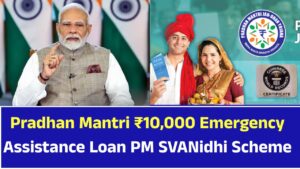Modi Loan : Pradhan Mantri ₹10,000 Emergency Assistance Loan PM SVANidhi Scheme
1. Introduction – A Ray of Hope in Difficult Times
India is a land of hardworking people. From small towns to metropolitan cities, the heartbeat of our economy is not only the big industries but also the millions of small vendors, shopkeepers, and street sellers who bring daily goods to citizens. Whether it is a tea stall at the corner of a busy road, a fruit cart in the local market, or a small roadside cobbler, these micro-entrepreneurs are the true engines of our society.

When the COVID-19 pandemic struck in early 2020, life suddenly came to a standstill. Markets were closed, streets were empty, and thousands of vendors who lived on daily income faced unimaginable challenges. They had no fixed salary, no savings to fall back on, and no way to continue their business. The survival of entire families was at stake.
At this crucial moment, the Government of India, under the leadership of Prime Minister Narendra Modi, launched the Pradhan Mantri Street Vendor’s AtmaNirbhar Nidhi (PM SVANidhi) scheme in June 2020. This scheme became famous as the ₹10,000 Emergency Assistance Loan because it offered vendors a chance to borrow up to ₹10,000 as working capital without any collateral.
The launch of PM SVANidhi was nothing less than a ray of hope. For lakhs of families, it meant the difference between despair and survival. For many more, it became a stepping stone to growth, prosperity, and dignity. The scheme is a success story of empowerment, inclusion, and resilience.
This article celebrates the good news of PM SVANidhi. It is not just about loans and money. It is about dreams, opportunities, and transformation. It is about how India’s smallest businesses are now becoming stronger, prouder, and digitally empowered.
2. A Historic Launch – Recognizing Street Vendors for the First Time
Street vendors have always been an important part of India’s economy, but for decades, they were ignored by the formal financial system. Banks rarely gave them loans because they had no collateral. Governments rarely recognized them in official policies.
The launch of PM SVANidhi in June 2020 changed this situation forever. For the first time in Indian history:
- Street vendors were officially recognized by the central government.
- A nationwide database of street vendors was prepared.
- A special digital platform and mobile app were launched for loan applications.
- Vendors were given ID cards, certificates of vending, and access to formal banking.
This was good news in every sense. Suddenly, a chaiwala, a vegetable seller, or a flower vendor had the dignity of being recognized as an entrepreneur. They were no longer “informal” or “invisible.” They became part of India’s development story.
3. Objectives of PM SVANidhi – The Positive Vision
The PM SVANidhi scheme was not just designed to give money. It was designed with a vision of transformation. The key objectives included:
- Providing Immediate Relief
- Vendors who lost their income during the lockdown were given an instant financial lifeline of ₹10,000 working capital.
- This helped them buy goods, restart their stalls, and continue serving customers.
- Encouraging Self-Reliance (Atmanirbhar Bharat)
- Instead of free handouts, the scheme encouraged dignified self-employment.
- Vendors took loans, repaid them, and grew their businesses step by step.
- Promoting Digital Inclusion
- Vendors were encouraged to use UPI, QR codes, and mobile wallets.
- Cashless payments gave them more customers and more income.
- Building Credit History
- By repaying loans on time, vendors built a credit score.
- This gave them access to higher loans in the future.
- Gradual Growth and Expansion
- The scheme started with ₹10,000, but vendors who repaid on time could move to ₹20,000 and then ₹50,000.
- This created a culture of progressive growth.
This vision was truly positive and inclusive. It was not charity; it was empowerment. It was not temporary relief; it was a long-term solution.
4. The First Loan – Small Amount, Big Impact
The first loan under PM SVANidhi was ₹10,000 for one year. At first glance, some people thought it was a small amount. But for a street vendor, this amount was nothing less than a new beginning.
Imagine a fruit seller in Delhi. During the lockdown, his cart was empty. He had no money to buy fruits from the wholesale market. With the ₹10,000 loan:
- He could buy apples, bananas, and mangoes.
- He could restart his stall and attract customers again.
- Within a few weeks, he earned enough to pay his daily expenses and slowly repay the loan.
This is why the ₹10,000 loan became a symbol of hope.
For some vendors, it meant buying raw materials.
For others, it meant repairing their stalls.
For women vendors, it meant becoming financially independent.
The beauty of the first loan is that it was:
- Collateral-free (no property needed as security)
- Quickly sanctioned through online/offline process
- Backed by government guarantee
